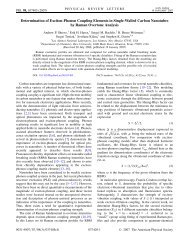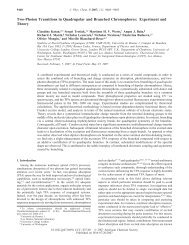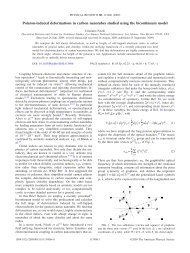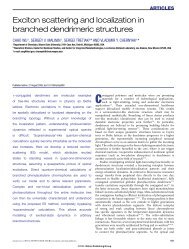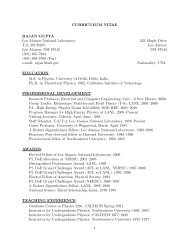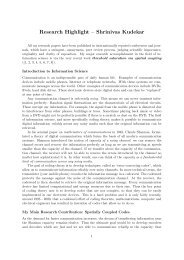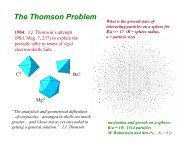R. Garimella and M. Shashkov, Polygonal Surface Mesh ...
R. Garimella and M. Shashkov, Polygonal Surface Mesh ...
R. Garimella and M. Shashkov, Polygonal Surface Mesh ...
Create successful ePaper yourself
Turn your PDF publications into a flip-book with our unique Google optimized e-Paper software.
Engineering with Computers (2004) 20: 265–272<br />
DOI 10.1007/s00366-004-0293-3<br />
ORIGINAL ARTICLE<br />
Rao V. <strong>Garimella</strong> Æ Mikhail J. <strong>Shashkov</strong><br />
<strong>Polygonal</strong> surface mesh optimization<br />
Received: 28 July 2003 / Accepted: 12 April 2004 / Published online: 23 July 2004<br />
Ó Springer-Verlag London Limited 2004<br />
Abstract A procedure has been developed to improve<br />
polygonal surface mesh quality while maintaining the<br />
essential characteristics of the discrete surface. The surface<br />
characteristics are preserved by repositioning mesh<br />
vertices so that they remain on the original discrete<br />
surface. The repositioning is performed in a series of<br />
triangular-facet-based local parametric spaces. The<br />
movement of the mesh vertices is driven by a nonlinear<br />
numerical optimization process. Two optimization approaches<br />
are described, one which improves the quality<br />
of elements as much as possible <strong>and</strong> the other which<br />
improves element quality but also keeps the new mesh as<br />
close as possible to the original mesh.<br />
Keywords <strong>Polygonal</strong> surface mesh Æ Element quality Æ<br />
Jacobian condition number Æ Reference Jacobian<br />
matrices<br />
1 Introduction<br />
This paper describes a procedure to improve the quality<br />
of polygonal surface meshes by node repositioning while<br />
preserving the essential characteristics of the discrete<br />
surface <strong>and</strong> keeping the mesh close to the original configuration.<br />
The need for improvement of such meshes<br />
arises primarily in finite volume simulations where they<br />
form interior <strong>and</strong> exterior boundaries of general polyhedral<br />
meshes.<br />
While previous research has focused on improving<br />
the quality of triangular <strong>and</strong> quadrilateral meshes [1–7],<br />
little attention has been paid to the improvement of<br />
polygonal meshes. Most of this work is devoted to<br />
smoothing (denoising) of a discrete surface represented<br />
R. V. <strong>Garimella</strong> (&) Æ M. J. <strong>Shashkov</strong><br />
MS B284, Los Alamos National Laboratory,<br />
Los Alamos, New Mexico 87545, USA<br />
E-mail: rao@lanl.gov<br />
E-mail: shashkov@lanl.gov<br />
by polygons (e.g., [8, 9]) rather than improving the<br />
quality of the polygonal elements in the surface mesh. In<br />
earlier work [7, 10], the authors presented a method for<br />
improving the quality of triangular <strong>and</strong> quadrilateral<br />
surface meshes in the absence of an underlying smooth<br />
surface. This paper extends <strong>and</strong> improves this technique<br />
to allow smoothing of surface meshes with general<br />
polygonal elements.<br />
The rest of the paper is organized as follows. The next<br />
section describes the minimization of an objective<br />
function with respect to local parametric coordinates.<br />
That section discusses the element-based local parameterization,<br />
line search in local parametric coordinates,<br />
<strong>and</strong> moving vertices from one parametric space to another.<br />
The section titled ‘‘Optimization of surface mesh<br />
quality’’ discusses specific objective functions for optimizing<br />
the quality of surface meshes. Finally, the<br />
‘‘Results’’ section presents several examples of optimization<br />
of surface meshes to demonstrate the capabilities<br />
of the methods.<br />
2 Optimization with respect to parametric coordinates<br />
Consider an objective function, Y(x), defined in terms of<br />
the real coordinates, x, of all the vertices of a surface<br />
mesh. The objective function is defined such that its<br />
minimization drives the mesh vertices to locations that<br />
improve the mesh, with respect to some quality measure.<br />
If this objective function is minimized directly, with respect<br />
to the real coordinates of the vertices, the search<br />
direction for the minimization may indicate vertex<br />
movement off the original surface mesh. To constrain<br />
the movement of the vertices to the discrete surface, the<br />
optimization must be performed with respect to the<br />
coordinates of the vertices in a 2D parametric space<br />
corresponding to the surface mesh. Assuming that there<br />
is no smooth surface underlying the discrete surface, one<br />
of several methods can be used to derive such a global<br />
parametric space from the surface mesh [11–15]. However,<br />
most of these methods involve substantial cost
266<br />
since they require the solution of a large system of<br />
equations that may be nonlinear.<br />
In this work, instead of using a global parametric<br />
space derived from the entire mesh, nodes are repositioned<br />
in a series of local parametric spaces. The local<br />
parametric spaces are derived from a mapping of mesh<br />
edges <strong>and</strong> triangular facets of mesh faces to canonical<br />
elements in 2D space, as is commonly done in finite<br />
element methods [16, 17]. Vertices on the boundary of<br />
the surface mesh (i.e., on a model edge) move in parametric<br />
spaces of boundary edges of the original mesh.<br />
The parametric space of each boundary mesh edge is<br />
derived by mapping it to a unit line segment along the<br />
x-axis, giving rise to parametric coordinate 0 £ s 0 £ 1.<br />
Vertices in the interior of the surface mesh (i.e., on a<br />
model face) move in parametric spaces derived from<br />
faces of the original mesh. The parametric space for a<br />
mesh triangle is derived using a barycentric mapping<br />
[17], resulting in parametric coordinates 0 £ (s 1, s 2) £<br />
1 (Fig. 1a). Quadrilaterals <strong>and</strong> more general polygons<br />
are considered to be made up of triangular facets<br />
(Fig. 1b) <strong>and</strong> a parametric space is derived for each facet<br />
as before. The facetization of polygons is computed by<br />
choosing a central point <strong>and</strong> connecting it to the polygon<br />
edges. To choose the central point, a full quadric:<br />
Z 0 ¼ aX 02 þ bX 0 Y 0 þ cY 02 þ dX 0 þ eY 0 þ f ð1Þ<br />
is first fitted to the polygon’s vertices in a rotated frame<br />
{X¢, Y¢, Z¢} [18, 19] anchored at the centroid of the<br />
polygon. The central point to be connected to the polygon’s<br />
edges is chosen as the point (0, 0, f) in the rotated<br />
frame. If the polygon does not have enough points to fit<br />
Fig. 1 a Barycentric mapping for triangle. b Triangular facetization<br />
of polygon<br />
a full quadric, additional points from the polygon’s<br />
neighborhood are used.<br />
The optimization procedure keeps track of the facet of<br />
the original mesh face that each vertex is moving in. The<br />
triangular facet in which a vertex is moving is referred to<br />
as the base triangle. The procedure also keeps track of the<br />
coordinates of the vertex in the parametric space of<br />
the base triangle. All objective function evaluations are<br />
done after mapping the parametric coordinates of the<br />
vertex in the base triangle to real coordinates. Also, the<br />
line search in the optimization procedure is conducted in<br />
the parametric space of the base triangle. The line search<br />
is used to find a step size, a, along a search direction, d,in<br />
the local parametric space, while respecting parametric<br />
bounds <strong>and</strong> mesh validity constraints. If an element becomes<br />
invalid during a line search, then the step size is<br />
scaled back <strong>and</strong> the optimization is restarted along a new<br />
search direction. If the line search takes the point out of<br />
the parametric bounds of the base triangle, the optimization<br />
is stopped, the adjacent triangular facet is found,<br />
<strong>and</strong> the optimization is restarted in the parametric<br />
space of the new base triangle. Additional details of the<br />
optimization procedure are given in [7].<br />
3 Optimization of surface mesh quality<br />
3.1 Condition number shape measure<br />
for polygonal mesh faces<br />
The quality measure used for evaluating the shape of<br />
polygonal mesh faces is based on the condition number<br />
shape measure [20]. This measure is derived from the<br />
Jacobian matrix of an element mapping as described<br />
below.<br />
Consider a vertex, Vi, connected to a set of edges,<br />
EðViÞ, <strong>and</strong> faces, FðViÞ, as shown in Fig. 2. Assume that<br />
one of the faces, Fj 2 FðViÞ, has edges Ep 2 EðViÞ <strong>and</strong><br />
Eq 2 EðViÞ connected to vertex Vi. The triangle formed<br />
by edges Ep <strong>and</strong> Eq can always be mapped to a rightangled<br />
triangle in 2D space with Vi mapped to the origin,<br />
a unit vector, e¢ p, representing Ep along the x-axis<br />
<strong>and</strong> a unit vector, e¢ q, representing Eq along the y-axis in<br />
2D space. Then, the Jacobian matrix, Jji, of the mapping<br />
of the triangle to the right-angled triangle in 2D space,<br />
Fig. 2 Definition of edge vectors, ep <strong>and</strong> eq, for calculating the<br />
Jacobian of an element Fj at vertex Vi
evaluated at vertex Vi, is given by Jji ¼ ½epeqŠ where,<br />
ep <strong>and</strong> eq are 3D edge vectors, of lengths lp <strong>and</strong> lq, representing<br />
edges Ep <strong>and</strong> Eq, respectively. The condition<br />
number of the Jacobian matrix is defined as<br />
j Jji ¼ J 1<br />
ji<br />
F Jji F , where j j F is the Frobenius norm<br />
of its matrix oper<strong>and</strong>.<br />
Since J ji is a 3·2 matrix for a triangle in 3D, its<br />
inverse does not exist in the usual sense <strong>and</strong> a pseudoinverse<br />
has to be calculated by singular value decomposition<br />
methods. On the other h<strong>and</strong>, the Jacobian<br />
matrix of a triangle in 2D space is a 2·2 matrix whose<br />
condition number can be calculated more easily as:<br />
j Jji ¼<br />
l2 p þ l2q 2Aj<br />
ð2Þ<br />
where Aj is the area of the triangle formed by Ep <strong>and</strong> Eq<br />
[20, 21]. This condition number is only a function of the<br />
triangle side lengths 1 ; therefore, it is invariant with<br />
rotation of the triangle in the plane. Since there always<br />
exists a coordinate system in which an arbitrarily oriented<br />
triangle lies on one of its coordinate planes, it<br />
suggests that the condition number is also useful for<br />
measuring the quality of arbitrarily oriented triangles in<br />
space.<br />
The condition number shape measure, as described<br />
above, measures the deviation of an element corner from<br />
a right-angled corner formed by unit edge vectors. Based<br />
on this property, a quality measure for a polygonal<br />
element may be defined as the sum of the Jacobian<br />
condition numbers at the polygon’s corners. This sum<br />
reaches a minimum when the polygon is regular.<br />
Note that that Jacobian condition number at an<br />
element corner is singular when the area, Aj, of the triangle<br />
formed by the corner is zero <strong>and</strong> is negative if the<br />
area is negative. Therefore, the Jacobian condition<br />
number is not a valid shape measure for polygons with<br />
concave or reentrant corners.<br />
3.2 Condition number based optimization<br />
Consider the minimization of a function defined as the<br />
sum of condition numbers of the face corners incident at<br />
a given vertex, Vi, as given below:<br />
w c<br />
i xi<br />
ð Þ ¼ X<br />
j<br />
j<br />
j JjiðxiÞ ¼ X l2 p xi ð Þþl2 q xi ð Þ<br />
; j 2 jjFj 2 FðViÞ ð3Þ<br />
AjðxiÞ where lp <strong>and</strong> lq are the lengths of the respective edges, Ep<br />
<strong>and</strong> Eq, of face Fj connected to vertex Vi, <strong>and</strong>xiis the<br />
coordinate vector of Vi.<br />
The minimization of w c<br />
i attempts to smooth the distribution<br />
of face angles <strong>and</strong> edge lengths around a vertex<br />
1 Aj is a function of the lengths of the triangle sides<br />
since all the edge vector pairs are trying to reach equal<br />
length <strong>and</strong> form a right angle. Based on this property, a<br />
strategy can be formed for improving the quality of a<br />
mesh by minimizing a global condition number based<br />
objective function, Y c , defined as:<br />
w c ¼ X<br />
~w c<br />
i<br />
j<br />
j<br />
w c<br />
i ; i 2 ijVi f 2 Vg<br />
ð4Þ<br />
where V is the set of all mesh vertices.<br />
For efficiency reasons, the global function Y c is, in<br />
reality, minimized by minimizing a local function, ~ w c<br />
i ,at<br />
each vertex. The value of ~ w c<br />
i at a vertex Vi is composed<br />
of all terms of Y c that involve the coordinates of Vi. Therefore, ~ w c<br />
i is formed by visiting each element, Fj, connected to vertex Vi, <strong>and</strong> adding the Jacobian condition<br />
number of the element at Vi <strong>and</strong> the Jacobian<br />
condition numbers at both of its edge-connected neighbors<br />
in that element (see Fig. 3). Mathematically, this is<br />
written as:<br />
X X<br />
¼ j Jjk ; j 2 jjFj 2 FðViÞ ;<br />
k<br />
k 2 kjVk 2 V Fj \ VEVi ð ð ÞÞ<br />
ð5Þ<br />
Note that the presence of Aj in the denominator acts as<br />
a barrier that discourages vertex movements that make<br />
the triangle formed by Ep <strong>and</strong> Eq degenerate. However,<br />
for some optimization techniques, it may still be necessary<br />
to explicitly check if the optimization process is<br />
forcing the vertices to jump across the degeneracy barrier.<br />
3.3 Reference Jacobian based optimization<br />
3.3.1 Motivation<br />
267<br />
The global condition number minimization procedure<br />
allows mesh vertices to move along the surface as much<br />
as necessary to minimize the objective function, Y c .<br />
However, in certain situations, it is of interest to keep<br />
the vertices of the original mesh as close as possible<br />
to their original locations while improving the shape of<br />
the mesh elements. Keeping the vertices close to their<br />
original positions facilitates accurate interpolation of<br />
Fig. 3 Vertices involved in the local objective function expression,<br />
~w c<br />
i , for Vi. The shaded circles along with the black circle (Vi)<br />
represent the vertices at which the Jacobian is computed for use in<br />
~w c<br />
i . The white circles represent vertices whose real locations do not<br />
contribute to the Jacobian at Vi
268<br />
solution data from one mesh to another, <strong>and</strong> also preserves<br />
mesh characteristics, such as refinement <strong>and</strong><br />
anisotropy. The reference Jacobian matrix (RJM) based<br />
optimization [7, 10, 21, 22] is used here to achieve the<br />
multiple objectives of improving mesh quality <strong>and</strong><br />
minimizing the change to the original mesh.<br />
The RJM mesh improvement is a two-stage procedure,<br />
consisting of a series of local condition number<br />
based optimizations <strong>and</strong> a global RJM optimization, as<br />
described next.<br />
3.3.2 Local condition number based optimization (step I)<br />
This is the first stage of the RJM optimization strategy.<br />
In this step, the locally optimal position of each mesh<br />
vertex is computed with respect to the fixed position of<br />
its neighbors. The objective function for optimization is<br />
the local condition number function, ~ w c<br />
i , described in<br />
Eq. 5, in the section titled ‘‘Condition number based<br />
optimization’’. However, in this step, the vertex is not<br />
moved to its locally optimal position. Rather, the optimal<br />
position of each vertex, described by a base face <strong>and</strong><br />
the parametric coordinates of the vertex in the base face,<br />
is stored as a virtual position for use in the second stage<br />
of the mesh improvement procedure.<br />
3.3.3 Reference positions, reference edges<br />
<strong>and</strong> the reference Jacobian matrix<br />
The locally optimal position computed <strong>and</strong> stored for<br />
each vertex in the first stage of the procedure is known as<br />
the reference position for the vertex. After reference<br />
positions are calculated for all mesh vertices, two reference<br />
edge vectors are calculated for each edge in the<br />
mesh; each reference edge vector goes from the reference<br />
position of one vertex of the edge to the original position<br />
of the other. The idea of reference edges is illustrated in<br />
Fig. 4, where E m is an edge with vertices V a <strong>and</strong> V b. The<br />
reference positions of V a <strong>and</strong> V b are V a R <strong>and</strong> Vb R ,<br />
respectively. The two reference edge vectors for E m are<br />
(e m R )a <strong>and</strong> (e m R )b, where the outer subscript indicates<br />
which of the vertices is at its reference position.<br />
Using the concept of reference edge vectors, it is now<br />
possible to define reference Jacobian matrices (RJMs)<br />
just as Jacobian matrices were defined for a mesh<br />
without reference positions. Therefore, if the edges of<br />
face F j connected to vertex V i are E p <strong>and</strong> E q, their<br />
reference edges are E p R <strong>and</strong> Eq R , <strong>and</strong> their reference<br />
edge vectors are (e p R )i <strong>and</strong> (e q R )i respectively, then the<br />
reference Jacobian of Fj at Vi is defined as J R ji ¼<br />
eR p<br />
i<br />
eR h i<br />
q<br />
i<br />
.<br />
3.3.4 Global optimization based on reference<br />
Jacobian matrix (step II)<br />
The second stage of the mesh improvement procedure is<br />
a global optimization based on the definition of RJMs.<br />
The goal of this step is to find a valid mesh configuration<br />
Fig. 4 Reference positions <strong>and</strong> reference edge vectors<br />
such that each edge is in a compromise configuration<br />
between its pair of reference edges. It is expected that<br />
such a configuration for the edges will improve mesh<br />
quality since the reference edge vectors were formed by<br />
locally improving mesh quality at each mesh vertex. It is<br />
also expected that the optimized mesh will not deviate<br />
drastically from the base mesh, since each reference edge<br />
vector has one of its vertices at its original position <strong>and</strong><br />
the other at the locally optimal position.<br />
The objective function for the global optimization<br />
quantifies the difference between the Jacobian matrices<br />
of the current mesh configuration <strong>and</strong> the RJMs as<br />
shown below:<br />
w R ¼ X X<br />
i<br />
j<br />
Jji J R 2<br />
ji<br />
F<br />
2<br />
Jji Aj AR ji<br />
; i 2 fijVi2Vg; j 2 jjFj 2 FðViÞ ð6Þ<br />
where V is the set of all mesh vertices <strong>and</strong> A ji R is the<br />
area of the triangle formed by edge vectors, (e p R )i <strong>and</strong><br />
(e q R )i. Note that, similar to the objective function for<br />
local optimization, the objective function includes a<br />
barrier term, A j, in the denominator in the form of the<br />
triangle area to prevent mesh invalidity. Since the<br />
Jacobian matrix <strong>and</strong> the RJM are formed from the mesh<br />
edges <strong>and</strong> the reference edges, respectively, optimization
of Y R makes the edges of the final mesh as close as<br />
possible to their respective reference edge vectors.<br />
As with the condition number based optimization,<br />
the global objective function, Y R is minimized by iteratively<br />
minimizing a local component of the global<br />
function at each mesh vertex. The local component of<br />
the global objective function that involves the real <strong>and</strong><br />
reference positions of V i is given as:<br />
~w R<br />
i<br />
X X<br />
¼<br />
j<br />
k<br />
Jjk J R jk<br />
2<br />
2<br />
Jjk Aj AR jk<br />
; j 2 jjFj 2 FðViÞ ;<br />
k 2 kjVk 2 V Fj \ VEVi ð ð ÞÞ<br />
In the above expression, the outer sum is over all faces<br />
connected to the vertex <strong>and</strong> the inner sum is over all<br />
vertices of a face that include Vi itself, or are edge-connected<br />
to Vi. 4 Results<br />
Figure 5 shows a simple example to illustrate the effects<br />
of a condition number optimization (CNO) <strong>and</strong><br />
Fig. 5 a Original mesh. b <strong>Mesh</strong> optimized with condition number<br />
objective function, c Optimized with reference Jacobian objective<br />
function. Note that, in both cases, the apex vertex is on the lateral<br />
surface of the original pyramid<br />
269<br />
reference Jacobian based optimization (RJO) on a<br />
nonplanar surface mesh. Figure 5a shows the original<br />
pyramid-shaped mesh on which the two optimization<br />
techniques are applied. Figure 5b shows the effect of<br />
optimizing the CN objective function <strong>and</strong> Figure 5c<br />
shows the effect of optimizing the RJ objective function.<br />
In both cases, the apex vertex lies on the left lateral<br />
surface of the original pyramid. It can be seen that CNO<br />
improves the shapes of the triangles more than RJO. On<br />
the other h<strong>and</strong>, RJO results in lesser movement of the<br />
apex vertex from its original position.<br />
Figure 6a shows the polygonal mesh of a pig, <strong>and</strong><br />
Fig. 6b, c show the results of CNO <strong>and</strong> RJO on the<br />
mesh, respectively. It is again clear from the example<br />
that CNO improves the shape of mesh elements more<br />
than RJO, but it also causes much more movement of<br />
the vertices. In particular, note that CNO destroys much<br />
of the anisotropy in the midsection of the pig <strong>and</strong><br />
smooths away the local refinement around the pig’s<br />
mouth while RJO preserves these characteristics of the<br />
mesh. Table 1 shows the histograms of the normalized<br />
average condition number of elements before <strong>and</strong> after<br />
Fig. 6 a <strong>Mesh</strong> of pig with anisotropy <strong>and</strong> local refinement. b <strong>Mesh</strong><br />
optimized with global condition number objective function. c <strong>Mesh</strong><br />
optimized with reference Jacobian objective function
270<br />
Table 1 Histograms of normalized average condition number of<br />
elements in original <strong>and</strong> optimized polygonal meshes of a pig<br />
(Fig. 6)<br />
K Original CNO RJO<br />
1.0–1.5 1,100 2,668 1,768<br />
1.5–2.0 1,017 304 855<br />
2.0–3.0 736 49 364<br />
3.0–4.0 113 5 31<br />
4.0–5.0 25 1 7<br />
5.0–7.5 21 0 3<br />
7.5–10.0 11 1 0<br />
10.0–15.0 3 1 1<br />
15.0 3 0 0<br />
Table 2 Quantitative measures of the change in the mesh <strong>and</strong><br />
discrete surface characteristics for CNO <strong>and</strong> RJO for polygonal<br />
mesh of a pig (Fig. 6); all values, except the change in normals, are<br />
presented as a percentage of the problem size<br />
Measure CNO RJO<br />
Average change in normals 10.7° 4.1°<br />
Hausdorff distance 0.3% 0.1%<br />
Maximum vertex movement 7.8% 2.6%<br />
Average vertex movement 1.0% 0.2%<br />
the two types of optimization. The normalized average<br />
condition number for an element is defined as the mean<br />
of the condition numbers at the vertices of an element,<br />
normalized so that a regular polygon will produce a<br />
value of 1.<br />
Table 2 shows various quantities computed to measure<br />
the change in the meshes <strong>and</strong> the discrete surfaces<br />
using the two methods of optimization. In the table, the<br />
normalized Hausdorff distance is computed by finding<br />
the minimum distance from each vertex of the original<br />
mesh to the new mesh, taking the maximum of these<br />
distances [23, 24], <strong>and</strong> then normalizing it by the problem<br />
size. The problem size is defined as the maximum<br />
length of the domain along the three coordinate directions.<br />
The difference between discrete normals is the<br />
angle between the normal vector of quadrics fitted to the<br />
neighborhood of a vertex at its old <strong>and</strong> new locations<br />
[18, 19]. The maximum vertex movement is the maximum<br />
distance traveled by any vertex from its original<br />
position <strong>and</strong> the average vertex movement is the mean of<br />
the distance traveled by all vertices from their original<br />
positions; these are also normalized by the problem size.<br />
Finally, a complex mesh of an ‘‘Moai’’ statue is presented<br />
in Fig. 7 to illustrate the effectiveness of this<br />
procedure on large surface meshes. The original mesh for<br />
this model was obtained from the Web sites of Belyaev<br />
<strong>and</strong> Ohtake 2 <strong>and</strong> then converted into a polygonal mesh<br />
along with the application of some compression below<br />
the neck <strong>and</strong> stretching at the chest. The modified mesh<br />
(Fig. 7a) was used to obtain the optimized meshes shown<br />
2 http://www.mpi-sb.mpg.de/ belyaev/soft/ply/gallery.html<br />
Fig. 7 a <strong>Polygonal</strong> mesh of the Moai model (courtesy of Belyaev<br />
<strong>and</strong> Ohtake). b <strong>Mesh</strong> optimized with CN objective function. c<br />
<strong>Mesh</strong> optimized with RJ objective function<br />
in the example. CNO resulted in the mesh shown in<br />
Fig. 7b <strong>and</strong> RJO yielded the mesh shown in Fig. 7c.<br />
As with the pig, it can be seen in the Moai mesh that<br />
the CNO improves the mesh considerably but eliminates<br />
some significant features in the mesh (particularly the<br />
refinement) while the mesh obtained by RJO preserves
Table 3 Histograms of normalized average condition number in<br />
original <strong>and</strong> optimized meshes for Moai mesh (Fig. 7)<br />
K Original CNO RJO<br />
1.0–1.5 3,250 7,029 5,315<br />
1.5–2.0 2,155 464 1,722<br />
2.0–3.0 1,471 67 456<br />
3.0–4.0 383 8 58<br />
4.0–5.0 159 3 15<br />
5.0–7.5 111 2 5<br />
7.5–10.0 32 0 1<br />
10.0–15.0 7 1 1<br />
15.0 6 0 1<br />
Table 4 Quantitative measures of the change in the mesh <strong>and</strong><br />
discrete surface characteristics for CNO <strong>and</strong> RJO for Moai mesh<br />
(Fig. 7); all values except the change in normals are presented as a<br />
percentage of the problem size<br />
Measure CNO RJO<br />
Average change in normals 5.1° 2.2°<br />
Hausdorff distance 0.20% 0.09%<br />
Maximum vertex movement 3.7% 2.1%<br />
Average vertex movement 0.66% 0.19%<br />
these features. The condition number histograms for the<br />
three meshes are presented in Table 3 <strong>and</strong> the measures<br />
for change in surface characteristics are presented in<br />
Table 4.<br />
With respect to execution time, RJO is normally<br />
faster than CNO since the former causes lesser node<br />
movement. Timing statistics collected for the above test<br />
cases <strong>and</strong> other examples indicate that CNO takes<br />
10%–50% longer than RJO.<br />
5 Conclusions<br />
A procedure was presented to improve the quality of<br />
complex polygonal surface meshes without an underlying<br />
smooth surface using numerical optimization. The<br />
optimization is designed to improve the quality of the<br />
mesh faces without distorting the discrete surface too<br />
much. The vertices are kept on the original surface mesh<br />
using movement in local parametric spaces of mesh faces.<br />
Two methods were proposed for improving the<br />
quality of the surface mesh. The first method improved<br />
the quality of mesh elements as much as possible by<br />
minimizing a global condition number objective function<br />
by local iteration. The second method was the twostage<br />
reference Jacobian matrix or RJM-based method,<br />
which improved the mesh quality as well as minimized<br />
the movement of vertices from their original locations.<br />
The procedure has been successfully tested on a<br />
number of complex polygonal surface meshes. Several<br />
quantitative measures were presented to show that<br />
both types of optimizations do not distort the surface<br />
much.<br />
Acknowledgements The work of the authors was performed at Los<br />
Alamos National Laboratory operated by the University of<br />
California for the US Department of Energy under contract<br />
W-7405-ENG-36. Los Alamos National Laboratory strongly supports<br />
academic freedom <strong>and</strong> a researcher’s right to publish; as an<br />
institution, however, the Laboratory does not endorse the viewpoint<br />
of a publication or guarantee its technical correctness.<br />
References<br />
271<br />
1. Field DA (1988) Laplacian smoothing <strong>and</strong> Delaunay triangulations.<br />
Commun Appl Numerical Methods 4:709–712<br />
2. Freitag L, Jones M, Plassmann P (1995) An efficient parallel<br />
algorithm for mesh smoothing. In: Proceedings of the 4th<br />
international meshing roundtable (4IMR), Albuquerque, New<br />
Mexico, October 1995. S<strong>and</strong>ia National Laboratories, S<strong>and</strong>ia<br />
report SAND 95-2130, pp 47–58<br />
3. Zavattieri PD, Dari EA, Buscaglia GC (1996) Optimization<br />
strategies in unstructured mesh generation. Int J Numerical<br />
Methods Eng 39:2055–2071<br />
4. Knupp P (1998) Winslow smoothing on two-dimensional<br />
unstructured meshes. In: Proceedings of the 7th international<br />
meshing roundtable (7IMR), Dearborn, Michigan, October<br />
1998. S<strong>and</strong>ia National Laboratories, S<strong>and</strong>ia report SAND<br />
98-2250, pp 449–457<br />
5. Cannan SA, Tristano JR, Staten ML (1998) An<br />
approach to combined laplacian <strong>and</strong> optimization-based<br />
smoothing for triangular, quadrilateral <strong>and</strong> quad-dominant<br />
meshes. In: Proceedings of the 7th international meshing<br />
roundtable (7IMR), Dearborn, Michigan, October 1998.<br />
S<strong>and</strong>ia National Laboratories, S<strong>and</strong>ia report SAND 98-2250,<br />
pp 479–494<br />
6. Zhou T, Shimada K (2000) An angle-based approach to twodimensional<br />
mesh smoothing. In: Proceedings of 9th international<br />
meshing roundtable (9IMR), New Orleans, Louisiana,<br />
October 2000. S<strong>and</strong>ia National Laboratories, S<strong>and</strong>ia report<br />
SAND 2000-2207, pp 373–384<br />
7. <strong>Garimella</strong> RV, <strong>Shashkov</strong> MJ, Knupp PM (2004) Triangular<br />
<strong>and</strong> quadrilateral surface mesh quality optimization using<br />
local parameterization. Comput Methods Appl Mech Eng<br />
193(9–11):913–928<br />
8. Kuriyama S (1999) Diffusive smoothing of polygonal meshes<br />
with bias <strong>and</strong> tension control. Vis Comput 15(10):509–518<br />
9. Jose RS, Alberola C, Ruiz J (2001) Reshaping polygonal meshes<br />
with smooth normals extracted from ultrasound volume<br />
data: an optimization approach. Proc SPIE 4325:462–472<br />
10. <strong>Garimella</strong> RV, <strong>Shashkov</strong> MJ, Knupp PM (2002) Optimization<br />
of surface mesh quality using local parameterization. In: Proceedings<br />
of the 11th international meshing roundtable<br />
(11IMR), Ithaca, New York, September 2002. S<strong>and</strong>ia National<br />
Laboratories, pp 41–52, http://cnls.lanl.gov/ shashkov<br />
11. Giannakoglou KC, Chaviaropoulos P, Papailiou KD (1996)<br />
Boundary-fitted parametrization of unstructured grids on<br />
arbitrary surfaces. Adv Eng Soft 27:41–49<br />
12. Floater MS (1997) Parametrization <strong>and</strong> smooth approximation<br />
of surface triangulations. Comput Aid Geometric Des 14:231–<br />
250<br />
13. Sheffer A, de Sturler E (2001) Parameterization of faceted<br />
surfaces for meshing using angle-based flattening. Eng Comput<br />
17(3):326–337<br />
14. Desbrun M, Meyer M, Alliez P (2002) Intrinsic parameterizations<br />
of surface meshes. In: Proceedings of the Eurographics<br />
2002 conference, Saarbru¨cken, Germany, September 2002<br />
15. Guskov I (2002) An anisotropic mesh parameterization<br />
scheme. In: Proceedings of the 11th international meshing<br />
roundtable (11IMR), Ithaca, New York, September 2002.<br />
S<strong>and</strong>ia National Laboratories, pp 325–332<br />
16. Zienkiewicz OC, Taylor RL (1987) The finite element method,<br />
vol 1, 4th edn. McGraw-Hill, New York
272<br />
17. Hughes TJR (1987) The finite element method: linear static <strong>and</strong><br />
dynamic finite element analysis. Prentice Hall, Englewood<br />
Cliffs, New Jersey<br />
18. McIvor AM, Valkenburg RJ (1997) A comparison of local<br />
surface geometry estimation methods. Machine Vis Appl<br />
10:17–26<br />
19. Petitjean S (2002) A survey of methods for recovering quadrics<br />
in triangle meshes. ACM Comput Surveys 34(2):211–262<br />
20. Knupp PM (2000) Achieving finite element mesh quality via<br />
optimization of the Jacobian matrix norm <strong>and</strong> associated<br />
quantities. Part I—a framework for surface mesh optimization.<br />
Int J Numerical Methods Eng 48(3):401–420<br />
21. <strong>Shashkov</strong> MJ, Knupp PM (2001) Optimization-based reference-matrix<br />
rezone strategies for arbitrary Lagrangian-Eulerian<br />
methods on unstructured grids. In: Proceedings of the 10th<br />
anniversary international meshing roundtable (10IMR), Newport<br />
Beach, California, October 2001. S<strong>and</strong>ia National Laboratories,<br />
S<strong>and</strong>ia report SAND 2001-2976C, pp 167–176<br />
22. Knupp PM, Margolin LG, <strong>Shashkov</strong> MJ (2002) Reference<br />
Jacobian optimization-based rezone strategies for arbitrary<br />
Lagrangian Eulerian methods. J Comput Phys 176:93–128<br />
23. Cignoni P, Rocchini C, Scopigno R (1998) Metro: measuring<br />
error on simplified surfaces. Comput Graph Forum 17(2):<br />
167–174<br />
24. Huttenlocher DP, Kl<strong>and</strong>erman GA, Rucklidge WJ (1993)<br />
Comparing images using the Hausdorff distance. IEEE Trans<br />
Pattern Anal Mach Intell 15(3):850–863




